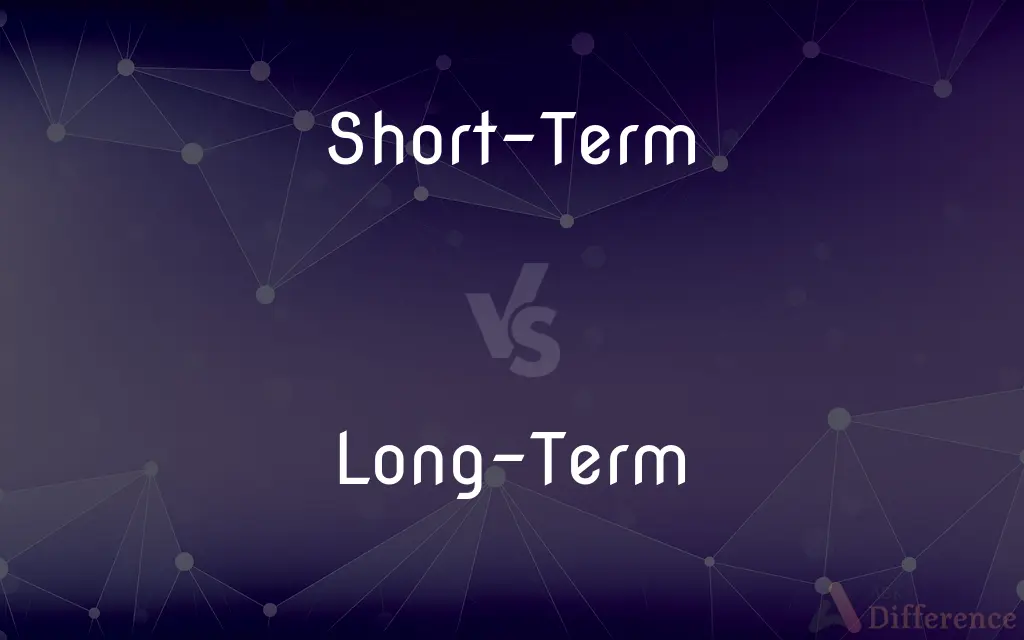Short-Term vs. Long-Term — What's the Difference?
By Tayyaba Rehman — Published on November 1, 2023
Short-Term refers to a brief period, typically up to a year, focusing on immediate objectives. Long-Term extends over a prolonged period, often several years, centering on sustained, future-focused goals and strategies.

Difference Between Short-Term and Long-Term
Table of Contents
ADVERTISEMENT
Key Differences
Short-Term commonly signifies a timeframe that encompasses immediate or near-future considerations, usually ranging from a few days to around a year. The considerations or strategies that are deemed "Short-Term" usually address immediate concerns, temporary goals, or transitional phases. They may often be characterized by a precise, tactical approach that seeks to navigate through the present or upcoming challenges or opportunities with timely responses and swift adaptations to the prevailing circumstances.
On the contrary, Long-Term spans an extended timeframe, typically stretching over several years or decades, and may even refer to a perpetual duration in certain contexts. Objectives, strategies, or implications deemed "Long-Term" tend to revolve around a forward-looking perspective, future-oriented goals, and gradual developmental or growth trajectories. They often involve comprehensive planning, strategic formulation, and sustained efforts, considering a wider array of variables and potential shifts over the impending years or decades.
In the realm of finance and investment, Short-Term is often associated with higher volatility and potential for quicker returns or losses. Strategies aimed at leveraging Short-Term movements might involve day trading or exploiting temporary market fluctuations. Such a focus necessitates a keen observation of market dynamics, agility in decision-making, and often a higher appetite for risk given the unpredictability inherent to shorter temporal frames.
Conversely, Long-Term financial investments or strategies commonly involve a more stable and prolonged commitment, where the expectation is typically oriented towards steady growth or returns over extended periods. Long-Term planning often involves a more in-depth analysis and a resilient approach that can withstand the ebb and flow of transient market fluctuations. It leans towards a patient, steadfast adherence to a predetermined strategy, often underpinned by thorough research and a well-considered risk mitigation plan.
Comparison Chart
Timeframe
Days to a year.
Several years to indefinite.
ADVERTISEMENT
Goal Focus
Immediate objectives.
Sustained, future-oriented goals.
Planning & Strategy
Tactical, adaptable plans.
Comprehensive, stable strategies.
Risk Tolerance (Finance)
Often higher due to volatility.
Generally lower, seeking steady growth.
Example Contexts
Day trading in markets.
Retirement planning.
Compare with Definitions
Short-Term
Lasting a brief period.
He took a Short-Term loan to manage immediate expenses.
Long-Term
Spanning across several phases or stages.
The Long-Term strategy involves multiple developmental stages.
Short-Term
Immediate or current in focus.
She adopted a Short-Term approach to solve the urgent issue.
Long-Term
Oriented towards distant future objectives.
The team focused on Long-Term sustainable practices.
Short-Term
Quick to start and conclude.
The Short-Term project will wrap up in three months.
Long-Term
Persistent and enduring in nature.
He invested with a Long-Term perspective in mind.
Short-Term
Temporary and often transient.
They hired workers on Short-Term contracts.
Long-Term
Persisting over consecutive periods.
The Long-Term study will track changes over a decade.
Short-Term
Involving or lasting a relatively brief time.
Long-Term
Extending over a lengthy period.
She secured a Long-Term lease for the apartment.
Short-Term
Payable or reaching maturity within a relatively brief time, such as a year
A short-term loan.
Long-Term
Involving, maturing after, or being in effect for a long time
A long-term investment.
Short-Term
Acquired over a relatively brief time
Short-term capital gains.
Long-Term
Becoming evident after a relatively long time period.
Short-Term
Of or pertaining to the near or immediate future.
This short-term plan deals with the next few days.
Long-Term
Extending over a relatively long time period.
Short-Term
Of or pertaining to a short duration of time
Short-term exposure
Long-Term
Over a relatively long period of time.
Short-Term
Over a relatively short period of time.
Long-Term
Same as long-run; as, the long-term consequences.
Short-Term
Relating to or extending over a limited period;
Short-run planning
A short-term lease
Short-term credit
Long-Term
Relating to or extending over a relatively long time;
The long-run significance of the elections
The long-term reconstruction of countries damaged by the war
A long-term investment
Short-Term
Pertaining to the near future.
The company announced its Short-Term plans amidst the crisis.
Common Curiosities
Can Short-Term goals influence Long-Term objectives?
Yes, Short-Term achievements or setbacks can impact Long-Term aspirations and planning.
Does Short-Term thinking hinder Long-Term planning?
Not necessarily, but a balance is crucial to ensure Short-Term actions do not derail Long-Term objectives.
What typically defines Short-Term and Long-Term timeframes?
Short-Term generally involves days to a year, while Long-Term spans several years or more.
Is one preferable over the other in investment scenarios?
It depends on the investor’s goals, risk tolerance, and investment strategy, as both Short-Term and Long-Term investments have their pros and cons.
Can a strategy be both Short-Term and Long-Term?
A strategy can have Short-Term components that align with and feed into Long-Term objectives and plans.
Are Long-Term plans always more beneficial?
Not always, as the effectiveness of Long-Term or Short-Term planning depends on the context and specific objectives.
Is Short-Term profit always at odds with Long-Term sustainability?
Not inherently, but a balanced approach ensures Short-Term profit doesn’t compromise Long-Term viability.
How do Short-Term and Long-Term perspectives impact decision-making?
Short-Term may focus on immediate implications, while Long-Term considers enduring impact and progression.
How often should Long-Term plans be revisited?
Regularly, to ensure they remain aligned with evolving contexts and objectives.
Can Short-Term and Long-Term investments coexist in a portfolio?
Absolutely, a diversified portfolio can strategically blend both investment horizons.
How does Short-Term finance differ from Long-Term finance?
Short-Term finance typically addresses immediate needs, while Long-Term finance is structured for sustained support.
Can Short-Term sacrifices yield Long-Term gains?
Often, yes. Strategic Short-Term sacrifices can sometimes be necessary to facilitate Long-Term achievements.
Can Short-Term failures undermine Long-Term success?
They can pose challenges but can also offer valuable lessons to inform and enhance Long-Term strategies.
How to balance Short-Term pressures and Long-Term goals?
Prioritize urgent needs while ensuring alignment and progression towards Long-Term objectives.
Which is riskier, Short-Term or Long-Term investments?
Short-Term investments often involve higher risks due to market volatility, while Long-Term is generally perceived as less risky due to the potential to recover from downturns over time.
Share Your Discovery

Previous Comparison
Active Site vs. Binding Site
Next Comparison
Customer Expectation vs. Customer PerceptionAuthor Spotlight
Written by
Tayyaba RehmanTayyaba Rehman is a distinguished writer, currently serving as a primary contributor to askdifference.com. As a researcher in semantics and etymology, Tayyaba's passion for the complexity of languages and their distinctions has found a perfect home on the platform. Tayyaba delves into the intricacies of language, distinguishing between commonly confused words and phrases, thereby providing clarity for readers worldwide.












































